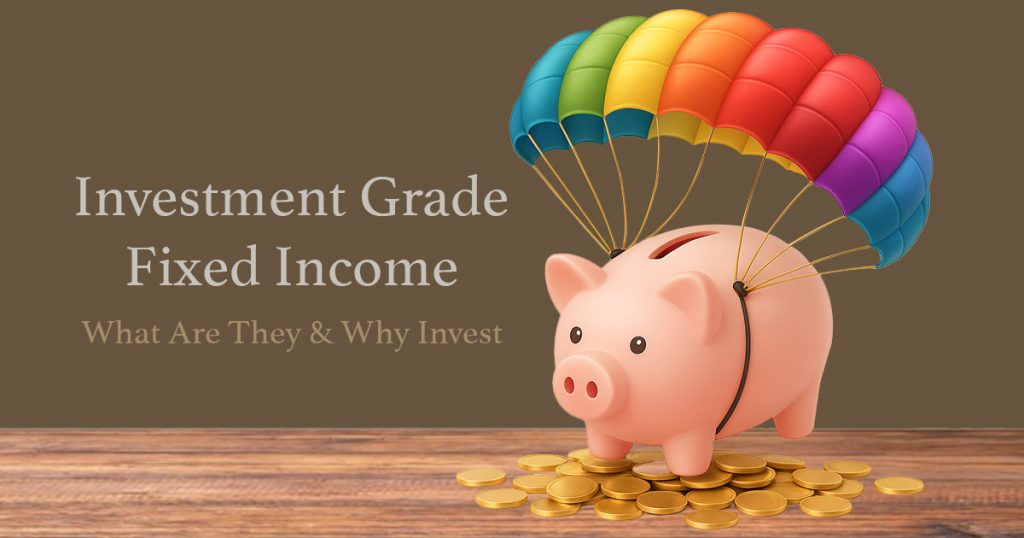When considering safe and steady investing, investment-grade fixed income often comes to mind. These investments appeal to people who prefer security and predictable returns over high-risk, high-reward options. Whether you’re nearing retirement or want to balance a stock-heavy portfolio, it helps to understand what investment-grade bonds are and why they matter. But before you invest in them, it’s important to understand what they are to help you see if they’re worth it to invest in.
Understanding Investment Grade Fixed Income
Investment-grade fixed income refers to bonds and similar securities that are considered low risk. These investments generate regular interest and return the principal when they mature. What makes them “investment grade” is their credit rating. Agencies like Moody’s, Standard & Poor’s, and Fitch assign ratings based on how likely an issuer is to repay its debt.
What is an Investment-Grade Rating?
A credit rating helps investors judge how likely a borrower is to repay its debt. Agencies like Moody’s and Standard & Poor’s assign these ratings based on financial strength, debt levels, and economic outlook. When a bond or fixed income security is rated AAA to BBB- by S&P, or Aaa to Baa3 by Moody’s, it’s considered investment grade.
This means the issuer has a strong track record of paying back what it owes. Anything rated below BBB- or Baa3 falls into high yield or junk territory, which carries more risk but may offer higher returns.
Some investment-grade bonds sit near the bottom of the scale. These BBB- or Baa3-rated bonds still qualify, but they’re more vulnerable to economic changes. If a company takes on too much debt or its earnings fall, its rating may drop. On the other hand, improving cash flow or cutting debt can lead to a rating upgrade.
Credit ratings aren’t set in stone. They change as companies and economies do, which is why investors need to stay informed.
What Are Investment Grade Bonds?
Investment-grade bonds include securities issued by governments, local municipalities, and financially strong corporations. These are organizations with good reputations, manageable debt, and a consistent track record of making payments.
A few common types of investment-grade fixed income include:
- Sovereign bonds – Issued by national governments with strong economies, such as the United States.
- Municipal bonds – Issued by local or state governments and may offer tax-exempt income.
- Corporate bonds – Offered by large, stable companies that show strong financial health.
These bonds are the building blocks of many conservative portfolios because they combine safety and income.
Why People Choose IG Bonds
Safety and Stability
IG bonds appeal to investors who want to protect their money. These bonds are generally more stable than stocks and less likely to default compared to high-yield bonds. For example, a government bond from the U.S. will usually have less risk than a bond from a startup tech company.
Reliable Income
Many people use investment-grade bonds to earn regular income. These bonds pay fixed interest, which helps cover expenses or reinvest for future growth. Even if you don’t need the income now, reinvesting those payments can help grow your wealth over time.
Tax Benefits
Some municipal IG bonds provide tax-exempt interest, which can be especially helpful for investors in higher tax brackets. This makes them a smart option for income-focused portfolios.
Investment Grade vs High Yield
Understanding the difference between IG bonds and high-yield bonds helps you choose the right mix for your portfolio. Investment-grade bonds usually pay lower interest but are safer. High-yield bonds offer higher returns, but they come with more risk.
Let’s say you’re in your 20s and comfortable with some ups and downs. High-yield bonds might be part of your strategy because you have time to recover from losses. But if you’re close to retirement and focused on preserving capital, investment-grade fixed income could be the better choice.
Some institutional investors, like pension funds, are even required to stick with investment-grade bonds because of their lower risk.
How the Economy Affects IG Bonds
The performance of IG bonds often depends on the state of the economy. When the market is uncertain or slowing down, people tend to move their money into safer assets like investment-grade fixed income. These bonds provide more stability during downturns.
When the economy is strong, riskier assets like high-yield bonds may become more attractive. Investors are more willing to chase higher returns because they feel more confident about future growth.
Interest rates also matter. Investment-grade bonds typically have longer durations, meaning they’re more sensitive to interest rate changes. When rates rise, prices of IG bonds usually fall more than high-yield bonds. However, when rates drop, IG bond prices often climb higher.
Why Ratings Shouldn’t Be Your Only Guide
Credit ratings are useful, but they’re not perfect. Agencies base their ratings on available information, but circumstances can change rapidly. The financial crisis of 2007-2008 revealed that some highly rated investments were not as safe as they appeared. Mortgage-backed securities received AAA ratings, but many were downgraded later when the market collapsed.
Always do your own research and don’t rely on a single rating when making decisions.
Make Stability Your Strategic Advantage
Market swings are hard to predict, but your response to them doesn’t have to be. Investment-grade fixed income gives you a way to stay invested without feeling exposed. It’s about playing it smart. Whether you’re just getting started or refining a long-term plan, let consistency and quality be the base you build on.
